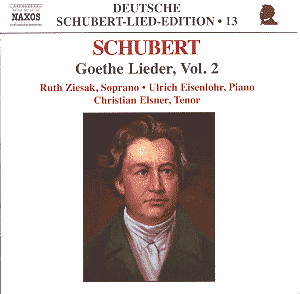Naxos’s
Schubert Lied edition tramps ever onward with the present offering
of Goethe-inspired pieces. Volume 1 (8.554665), featuring baritone
Ulf Bästlein and pianist Stefan Laux, was released back in
October 1999, so some collectors might have been holding their
breath for rather a long time. Was the wait worth it?.
Naxos’s
policy of choosing young German Lieder singers is a laudable one.
The pianist on this offering is also the project’s Artistic Advisor,
Ulrich Eisenlohr, who shows great sensitivity and good intent
always (if not providing the insights of his rival on Hyperion,
Graham Johnson). And Ruth Ziesak (the principal artist on this
disc) is well-respected as a singer who has recorded for a wide
variety of labels. Amongst her discography, Pamina (with Solti)
and Mahler Fourth Symphony (with Gatti) stand out.
Beginning
a recital with Sehnsucht, D310, in the concert hall would
be brave (of course it was almost certainly not the first Lied
in the sessions!). It is nearly all slow delicacy - the one more
impassioned passage requires a firm lower register (which here
taxes Ziesak). The piano sounds insubstantial, and too much in
the background.
A
little more body in the higher regions would not go amiss in some
other lieder, also (Nähe des Geliebten springs to
mind here). Nevertheless, Ziesak’s young-sounding voice does result
in a convincingly youthful portrayal in Gretchen am Spinnrade,
here unfortunately let down by a decidedly un-mesmeric piano/spinning
wheel. A nice idea to present a trio of Gretchen songs in sequence,
though: next comes Szene aus Faust, D126 (with a focused
Elsner as Evil Spirit and ‘Chorus’; not enough to erase memories
of his Schöne Müllerin, though! 8.554664: link).
The dramatic element is well-realised, and it is nice that Naxos
provide textual differences with Goethe’s original. Gretchen
im Zweiger, D564, is given an adequate airing by Ziesak.
The
main problem seems to be that Ziesak, while her voice is attractive
in short bursts, becomes tiring to listen to after just a few
Lieder. It is not only her vocal quality, more that the
songs tend to emerge much the same. At least Eisenlohr makes sufficient
textural gradations to keep the interest alive (try the beginning
of Suleika I, D720, for an example of his tonal sensitivity).
The
duet Mignon und der Harfner, D877 works well. Unfortunately
Ziesak’s vocal swoops in the folk-like Schweizerlied, D559
are off-putting (yodelling imitations, surely, but they just sound
like technical failings here). But perhaps it is the Lied der
Mignon (Nur wer die Sehnsucht kennt), D877, (track 21) that
best exemplifies this disc’s failings. Ziesak simply does not
have the interpretative maturity to conjure up the requisite intimacy.
Surely this Lied should make one hold one’s breath for fear of
disturbing the magic?. No chance here.
A
great pity also, that the recital ends with D321, in which Eisenlohr’s
technique sounds stretched by the tricky finger-work in the more
rapid passages.
Joachim
Landkammer’s booklet notes help the listener through the maze
of Mignons (An Mignon, Mignon I and II, Lieder
der Mignon …). A pity that the running order on the back of
the box does not concur with that in the booklet, though. The
booklet is correct: the second song we hear is Nahe des Geliebten,
not Rastlose Liebe.
To
refer back to my first paragraph: well, was the wait for Volume
2 worth it?. Alas, no. I cannot say in all truth that I shall
be searching my shelves for this disc too often in future, despite
some pleasant moments.
Colin
Clarke
For reviews of other releases in this
series,
see the Naxos
Deutsche Schubert-Lied Edition page

